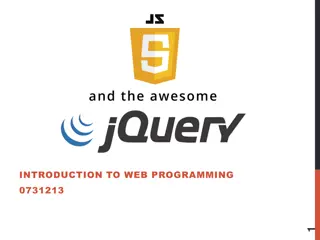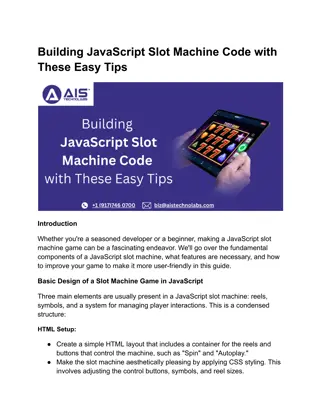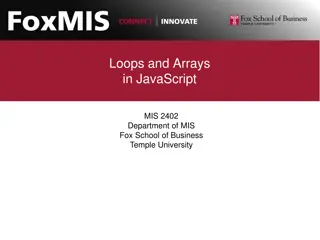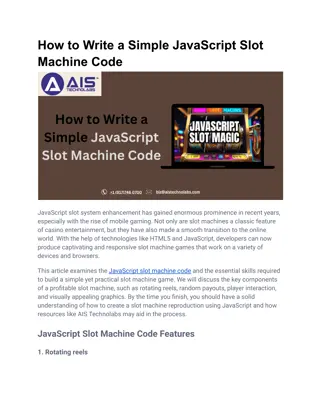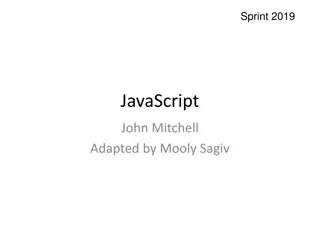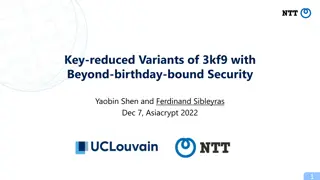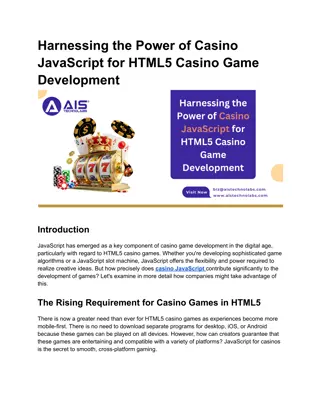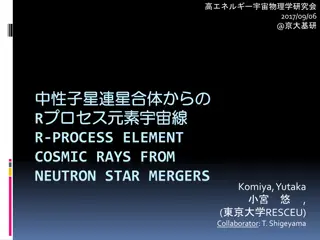Dynamic Parallelization of JavaScript Applications Using an Ultra-lightweight Speculation Mechanism
JavaScript Engine Optimization with Light-weight Software Speculation Mechanism for Automatic Parallelization of Programs. Explore the Background, Language Trend on GitHub, Popular JavaScript Engines, and more.
Download Presentation

Please find below an Image/Link to download the presentation.
The content on the website is provided AS IS for your information and personal use only. It may not be sold, licensed, or shared on other websites without obtaining consent from the author.If you encounter any issues during the download, it is possible that the publisher has removed the file from their server.
You are allowed to download the files provided on this website for personal or commercial use, subject to the condition that they are used lawfully. All files are the property of their respective owners.
The content on the website is provided AS IS for your information and personal use only. It may not be sold, licensed, or shared on other websites without obtaining consent from the author.
E N D
Presentation Transcript
Dynamic Parallelization of JavaScript Applications Using an Ultra-lightweight Speculation Mechanism ECE 751, Fall 2015 Peng Liu 1
Overview What? JavaScript Engine optimization How? Light-weight software speculation mechanism Automatic parallelization of general purpose programs with Thread-level speculation (TLS)[1][2] [1] Heine, David, et al. Software and hardware for exploiting speculative parallelism with a multiprocessor. Computer Systems Laboratory, Stanford University, 1997. [2] Hammond, Lance, Mark Willey, and Kunle Olukotun. Data speculation support for a chip multiprocessor. Vol. 32. No. 5. ACM, 1998. 2
Background JavaScript is popular on front-end programming (also on server side now) 3
Popular JavaScript Engines Mozilla: SpiderMonkey Google: V8 WebKit: JavaScript Core (Nitro, SquirrelFish) Microsoft: Chakra 5
About TraceMonkey TraceMonkey was the first JIT compiler written for the JavaScript language It is a part of SpiderMonkey It is a tracing JIT, which records control flow and data types during interpreter execution, then optimize the native code. Now obsolete. 6
JavaScript Performance baseline 7
Two Assumptions Execution time is dominated by hot loops for compute-intensive applications[1] Industry benchmarks are representative of JavaScript workloads [1] Richards, Gregor, et al. "An analysis of the dynamic behavior of JavaScript programs." ACM Sigplan Notices. Vol. 45. No. 6. ACM, 2010. 8
Static Parallelization Overview Find loops Speculate execution Problem: Large overhead for JIT compiler and speculation runtime! 9
ParaScript Dynamic Parallelization (1) (2) (3) 10
Loop Selection Only loops whose iterations is known at runtime are considered Other restrictions: No DOM interactions No HTTP request No eval , Function , setTimeOut , setInterval Find loops can be easily parallelized 11
Loop Selection (contd.) Parallelization Potential Analysis Iteration count Number of instructions per iteration 12
Dependence Assessment Low cost data flow analysis and runtime tests Detect cross-iteration memory dependences during the first several loop iterations High accuracy, but not 100% accurate 13
Scalar Dependences 100% accurate 14
Array Dependences Not 100% accurate 15
Parallel Code Generation original loop Iterations Chunk 1 Chunk 2 1 2 parallelized iterations in 2 threads Time saving Iterations Loop barrier Checkpoint Result cleanup Conflict check and chunk barrier 16
Speculation Mechanism Misspeculation detection Checkpointing and recovery 18
Speculative Parallelization with STM The overhead posed by STM may likely overshadow its promise[1] [1] Cascaval, Calin, et al. "Software transactional memory: Why is it only a research toy?." Queue 6.5 (2008): 40. 19
Conflict Detection Using Reference Counting For all objects involved with loop arrays Add a header (ref_count, array_list) At checkpointing time, go through all live-in array elements and store them in the state checkpoint. If an array item refers to an object, query the object s header If the object has been referenced by the same array before, conflict detected If the object has been referenced by other array before, conflict detected If the object has not been reference by other array, record current array and add 1 to the reference count 21
Conflict Detection Using Range-based Checks Each array maintains four local variables (rdMinIndex, rdMaxIndex) (wrMinIndex, wrMaxIndex) Every thread records the range of read and write access on the arrays. In conflictcheck(), checks the read and write access ranges of each array in each thread against write access ranges in all other threads Return true if any conflict is found 22
Instrumenting Array Functions Array manipulation functions are implemented inside JavaScript engine, and they access a range of items pop(), push(), reverse(), etc. 23
Checkpointing and Recovery Checkpointing Objects are deep-copied (global and local) Recovery in case of rollback request Cross-function speculation is not supported 24
Checkpointing Optimizations Selective variable cloning Only write accessed variables in the loop need to cloned. Array clone elimination e.g. getImageData(): don t clone the output of this function, but call this function again with the same parameters. 25
Evaluation ParaScript is implemented in SpiderMonkey SunSpider and a set of filters from Pixastic js image processing library are used for evaluation Not parallelizable programs were identified early in the dependences assessment stage, so no large performance overhead for them. 26
Potential Improvement of Parallelization 27
Conclusion For compute-intensive (not interaction- intensive, not memory intensive) JavaScript applications, ParaScript can speedup the execution. 30
Discussions Impact on power consumption? Will ParaScript work on latest JavaScript Engine? Explicit parallelism River Trail (PJS) - a parallel programming model and API for JavaScript[1] Web Workders + SharedArrayBuffer[2] SIMD.js[3] [1] Herhut, Stephan, et al. "River trail: a path to parallelism in JavaScript." ACM SIGPLAN Notices. Vol. 48. No. 10. ACM, 2013. [2] Dave Herman, The Path to Parallel JavaScript , https://blog.mozilla.org/javascript/2015/02/26/the-path-to-parallel-javascript/ [3] Benjamin Bouvier, The state of SIMD.js performance in Firefox , https://blog.mozilla.org/javascript/2015/03/10/state-of-simd-js-performance-in-firefox/ 31
Questions? 32


